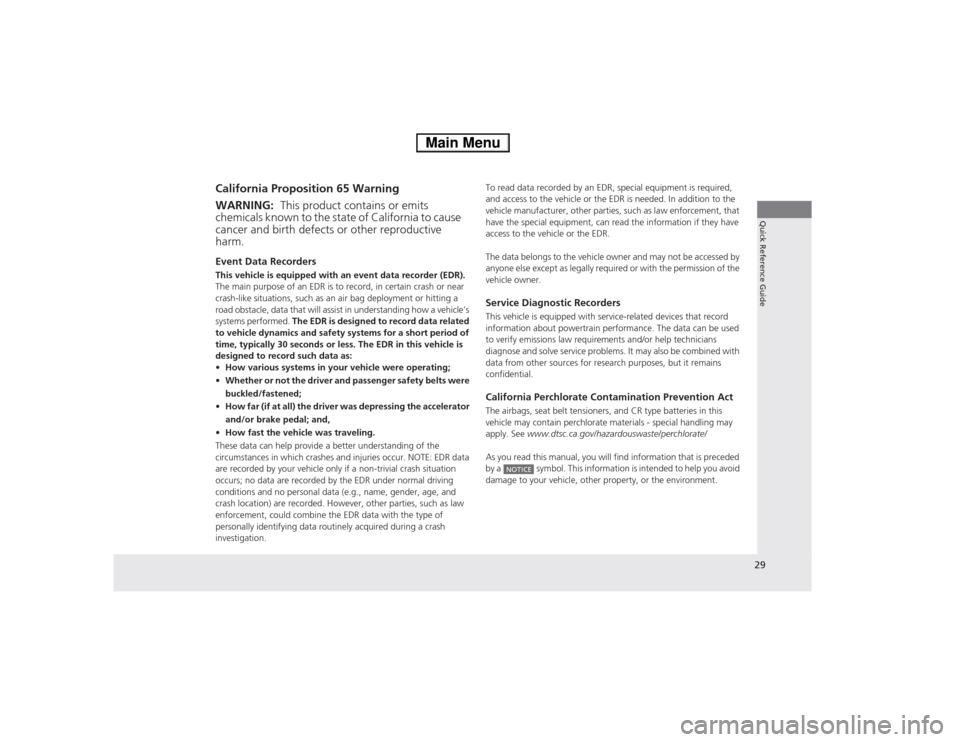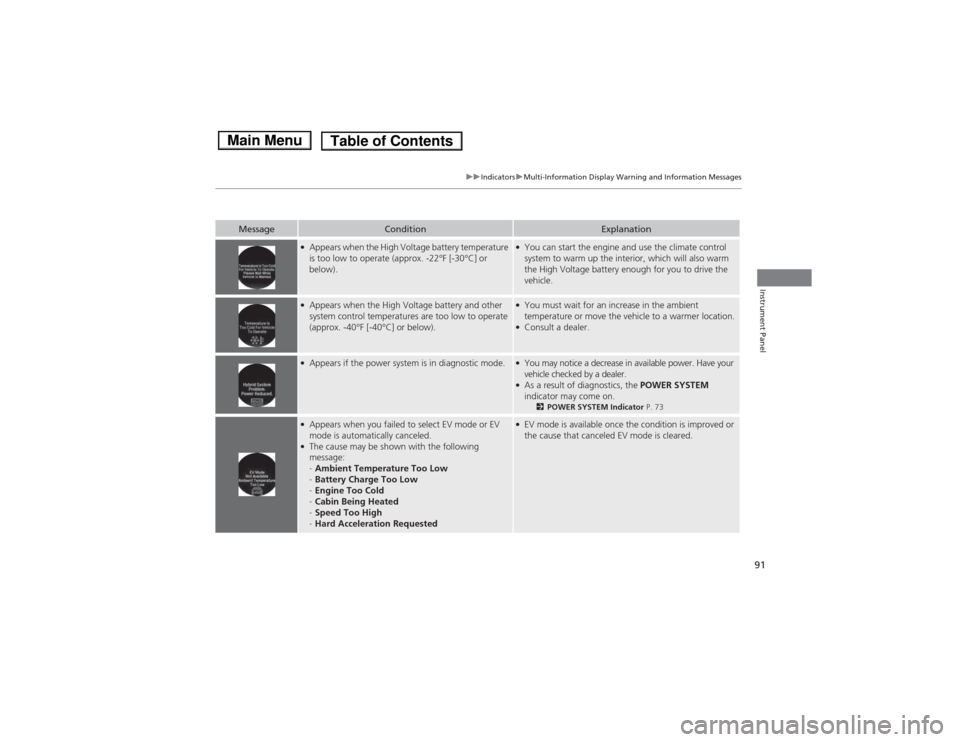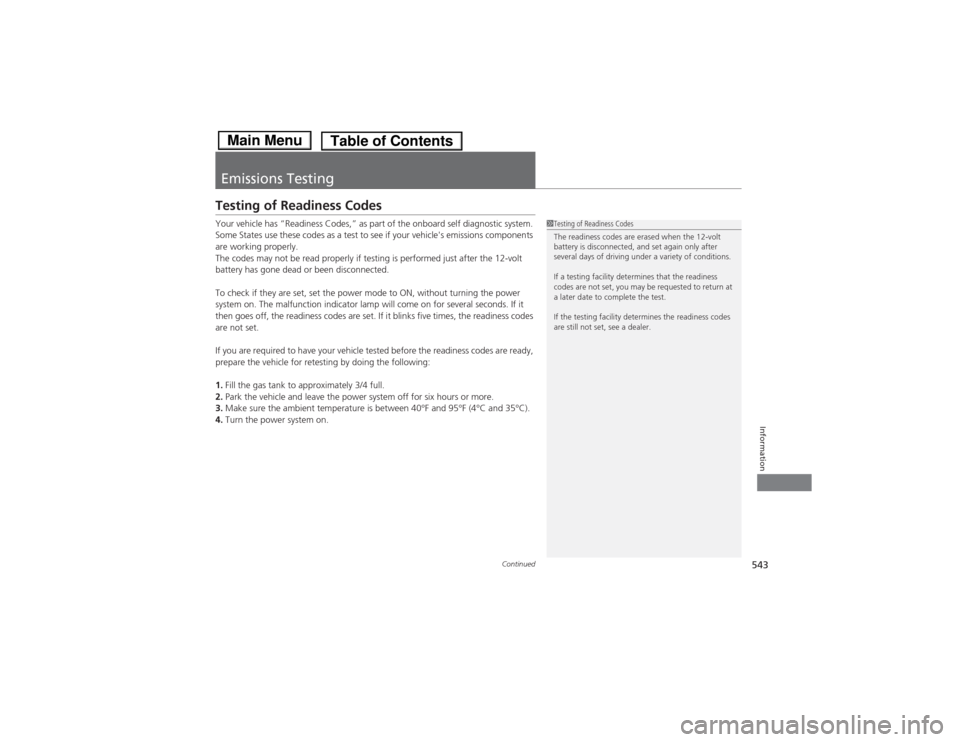2014 HONDA ACCORD HYBRID diagnostic menu
[x] Cancel search: diagnostic menuPage 30 of 561

29
Quick Reference Guide
California Proposition 65 Warning Event Data Recorders
This vehicle is equipped with an event data recorder (EDR).
The main purpose of an EDR is to record, in certain crash or near
crash-like situations, such as an air bag deployment or hitting a
road obstacle, data that will assist in understanding how a vehicle’s
systems performed. The EDR is designed to record data related
to vehicle dynamics and safety systems for a short period of
time, typically 30 seconds or less. The EDR in this vehicle is
designed to record such data as: • How various systems in your vehicle were operating;
• Whether or not the driver and passenger safety belts were
buckled/fastened;
• How far (if at all) the driver was depressing the accelerator
and/or brake pedal; and,
• How fast the vehicle was traveling.
These data can help provide a better understanding of the
circumstances in which crashes and injuries occur. NOTE: EDR data
are recorded by your vehicle only if a non-trivial crash situation
occurs; no data are recorded by the EDR under normal driving
conditions and no personal data (e.g., name, gender, age, and
crash location) are recorded. However, other parties, such as law
enforcement, could combine the EDR data with the type of
personally identifying data routinely acquired during a crash
investigation.
WARNING: This product contains or emits
chemicals known to the state of California to cause
cancer and birth defects or other reproductive harm.
To read data recorded by an EDR, special equipment is required,
and access to the vehicle or the EDR is needed. In addition to the
vehicle manufacturer, other parties, such as law enforcement, that
have the special equipment, can read the information if they have
access to the vehicle or the EDR.
The data belongs to the vehicle owner and may not be accessed by
anyone else except as legally required or with the permission of the
vehicle owner.
Service Diagnostic Recorders
This vehicle is equipped with service-related devices that record
information about powertrain performance. The data can be used
to verify emissions law requirements and/or help technicians
diagnose and solve service problems. It may also be combined with
data from other sources for research purposes, but it remains
confidential.
California Perchlorate Contamination Prevention Act
The airbags, seat belt tensioners, and CR type batteries in this
vehicle may contain perchlorate materials - special handling may apply. See www.dtsc.ca.gov/hazardouswaste/perchlorate/
As you read this manual, you will find information that is preceded
by a symbol. This information is intended to help you avoid
damage to your vehicle, other property, or the environment.
NOTICE
Main Menu
Page 75 of 561

74
uuIndicatorsu
Instrument Panel
IndicatorNameOn/BlinkingExplanationMessage
Low Oil Pressure
Indicator
●Comes on for a few seconds when
you set the power mode to ON,
then goes off.
● Comes on when the engine oil
pressure is low.●Comes on while driving - Immediately
stop in a safe place. 2If the Low Oil Pressure Indicator
Comes On P. 528
Malfunction Indicator Lamp
●
Comes on when you set the power
mode to ON, and goes off either
when the power system is on or
after several seconds if the vehicle
did not start. If “readiness codes”
have not been set, it blinks five
times before it goes off.
● Comes on if there is a problem
with the emissions control system.
● Blinks when a misfire in the
engine's cylinders is detected.●Readiness codes are part of the on board
diagnostics for the emissions control systems.
2Testing of Readiness Codes P. 543
● Comes on while driving - Have your
vehicle checked by a dealer.
● Blinks while driving - Stop in a safe
place where there are no flammable
objects. Stop the power system for 10
minutes or more, and wait for the engine
to cool down. Then, take the vehicle to a dealer. 2If the Malfunction Indicator Lamp
Comes On or Blinks P. 529
12-Volt Battery
Charging System
Indicator
●
Comes on when you set the power
mode to ON, and goes off when
the power system is on.
● Comes on when the 12-volt
battery is not charging.●
Comes on while driving - Turn off the
climate control system and rear defogger
in order to reduce electricity
consumption. 2If the 12-Volt Battery Charging
System Indicator Comes On P. 528
Main MenuTable of Contents
Page 92 of 561

91
uuIndicatorsuMulti-Information Display Warning and Information Messages
Instrument Panel
MessageConditionExplanation
●Appears when the High Voltage battery temperature
is too low to operate (approx. -22°F [-30°C] or
below).● You can start the engine and use the climate control
system to warm up the interior, which will also warm
the High Voltage battery enough for you to drive the vehicle.
●Appears when the High Voltage battery and other
system control temperatures are too low to operate
(approx. -40°F [-40°C] or below).● You must wait for an increase in the ambient
temperature or move the vehicle to a warmer location.
● Consult a dealer.
●
Appears if the power system is in diagnostic mode.● You may notice a decrease in availa ble power. Have your
vehicle checked by a dealer.
● As a result of diagnostics, the POWER SYSTEM
indicator may come on. 2POWER SYSTEM Indicator P. 73
●
Appears when you failed to select EV mode or EV
mode is automatically canceled.
● The cause may be shown with the following
message: -Ambient Temperature Too Low
- Battery Charge Too Low
- Engine Too Cold
- Cabin Being Heated
- Speed Too High
- Hard Acceleration Requested●
EV mode is available once the condition is improved or
the cause that canceled EV mode is cleared.
Main MenuTable of Contents
Page 544 of 561

543
Continued
Information
Emissions Testing
Testing of Readiness Codes
Your vehicle has “Readiness Codes,” as part of the onboard self diagnostic system.
Some States use these codes as a test to see if your vehicle's emissions components
are working properly.
The codes may not be read properly if testing is performed just after the 12-volt
battery has gone dead or been disconnected.
To check if they are set, set the power mode to ON, without turning the power
system on. The malfunction indicator lamp will come on for several seconds. If it
then goes off, the readiness codes are set. If it blinks five times, the readiness codes
are not set.
If you are required to have your vehicle tested before the readiness codes are ready,
prepare the vehicle for retesting by doing the following: 1.
Fill the gas tank to approximately 3/4 full.
2. Park the vehicle and leave the power system off for six hours or more.
3. Make sure the ambient temperature is between 40°F and 95°F (4°C and 35°C).
4. Turn the power system on.
1Testing of Readiness Codes
The readiness codes are erased when the 12-volt
battery is disconnected, and set again only after
several days of driving under a variety of conditions.
If a testing facility determines that the readiness
codes are not set, you may be requested to return at
a later date to complete the test.
If the testing facility determines the readiness codes
are still not set, see a dealer.
Main MenuTable of Contents